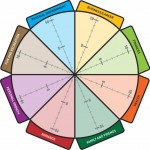 A common problem that everyone faces is feeling like their life is spinning out of control. This is usually a result of not living in congruency to what matters most to us. Most of the culprit is the challenge of balancing your work and personal life. I visualize a car heading in a direction and then finding that one of its wheels is losing air. Life coaching is all about airing up all the tires. The quick fix on getting back on track is to do some internal investigation into where the source of the leak lies. There are many tools out there, but the one of the favorites in coaching is the wheel of life. In coaching, the wheel of life is used to divide our life into major areas that when looked at holistically constitute what could make us feel like a whole balanced person.
A common problem that everyone faces is feeling like their life is spinning out of control. This is usually a result of not living in congruency to what matters most to us. Most of the culprit is the challenge of balancing your work and personal life. I visualize a car heading in a direction and then finding that one of its wheels is losing air. Life coaching is all about airing up all the tires. The quick fix on getting back on track is to do some internal investigation into where the source of the leak lies. There are many tools out there, but the one of the favorites in coaching is the wheel of life. In coaching, the wheel of life is used to divide our life into major areas that when looked at holistically constitute what could make us feel like a whole balanced person.
Generally, when someone feels out of control, what they are saying is that they feel unbalanced and something important is missing in their life, some section(s) of their wheel is flat and making them spin funny. Let’s take a look at how we could use the wheel of life to diagnose where you are out of balance. Here are 5 simple steps to help you diagnose where you are leaking air out of your time:
1. Draw your wheel: Identify all the key areas in your life that are important to you. Draw a circle (see diagram) and create a pie chart with all of your key areas. See the sample below that includes key areas such as personal growth, fun, etc. Each person will have their own number of slices and labels on their circle. Mark where you are on a scale to 1-10 on satisfaction with each area.
 2. Pick one area: Pick the one area of your life where you are really unsatisfied and that if you would make a change it would have the most impact in your life. For example, let’s say that we pick “family and friends”.
2. Pick one area: Pick the one area of your life where you are really unsatisfied and that if you would make a change it would have the most impact in your life. For example, let’s say that we pick “family and friends”.
3. Personal inquiry: Ask yourself what things you could do to substantially improve the one area you picked. In our current example, we’d ask what one thing could you do that would improve the “family” area? Let’s say one of the things you really want is to spend more quality time with her kids.
4. Developing a plan: The last step is to ask yourself what 1-3 actions could you do that would help you achieve your goal? In our current example, we’d ask what things we could do to create more quality time with her kids. Next, we’d prioritize one out of our list of 3 things and then commit to a date to complete one of the action item. When we’re done with our first action item, we can either move on to the next action item or see how things feel overall. The idea is to keep on moving through your action items until the hole is patched.
5. Moving to the next area: The nice thing about the wheel is about 90% of the time addressing one issue will end up resolving other areas in our life. It’s why the visual depiction is a wheel since all the pieces are connected. In our current example, you may find that you have less stress at work once you address the quality time with her child. If you still feel out of balance, then go back to Step 2 and repeat the process.
The wheel is such a great tool since you can use it over and over because the big areas in your life often stay constant. So, it’s conceivable that you could have the same wheel for a whole year or two. I like to think of this tool like the tire patch kit in your car. Keep it around so the next time your wheel loses some air, you can pull it out and make some diagnoses and fixes. Keep any worksheets you’ve written over time together since often the “how to fix” directions in an area are likely to apply in the future.
 Conscious Calling
Conscious Calling



